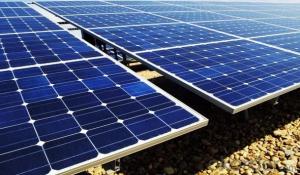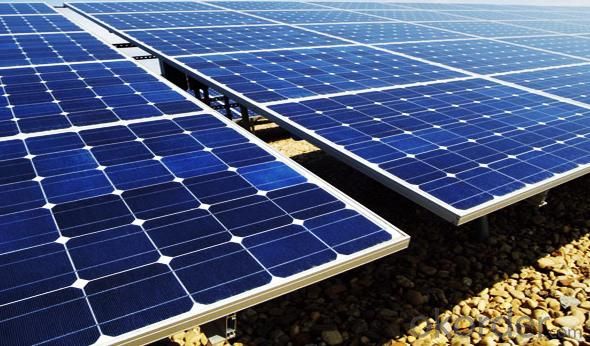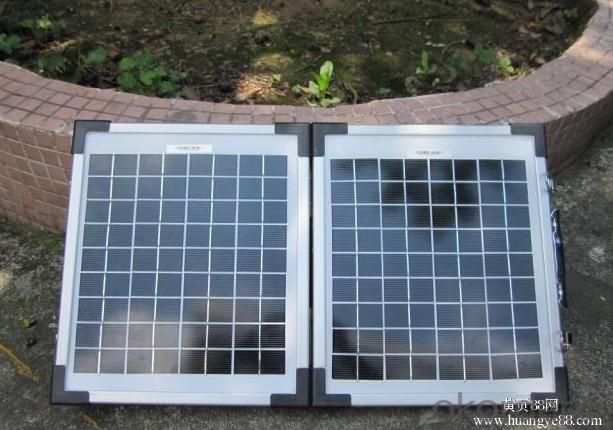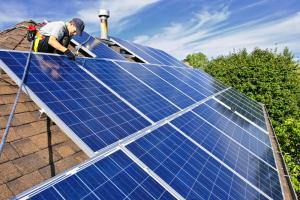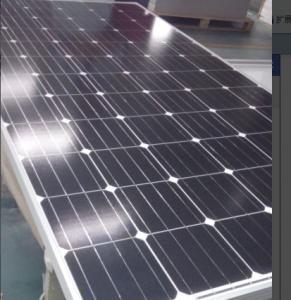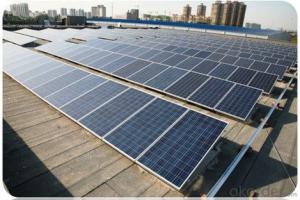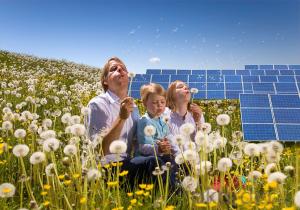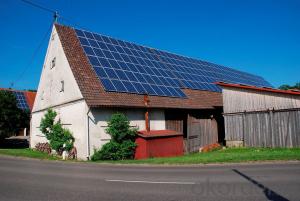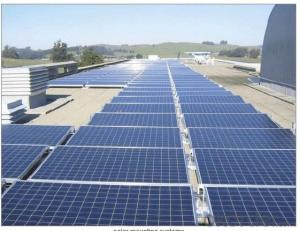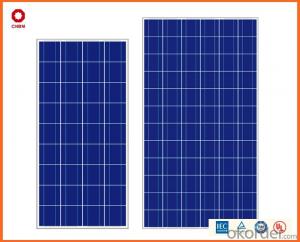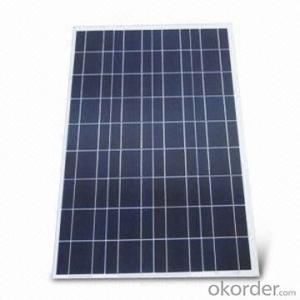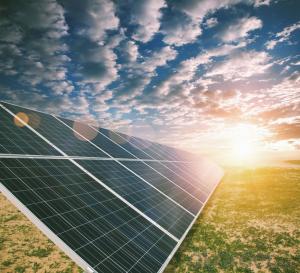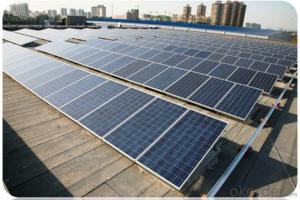290w/295w Solar Panels for Heating - Polycrystalline Silicon Certified
- Loading Port:
- Shanghai
- Payment Terms:
- TT OR LC
- Min Order Qty:
- 1000 watt
- Supply Capability:
- 100000000 watt/month
OKorder Service Pledge
OKorder Financial Service
You Might Also Like
Specification
290W/295W Solar Panel Polycrystalline Silicon Certificated
- TUV IEC, MCS (UK), CE, CEC (Australia), INMETRO, IDCOL, SONCAP CERTIFIED
- [EU ANTIDUMPING DUTY-FREE]
- PROFESSIONAL SOLAR PANEL MANUFACTURER SINCE 2004
FEATURES
`Long Service Life
`High Efficency Solar Cells
`Special Aluminum Frame Design
`High Transmission,Low Iron Tempered Glass - TUV IEC, MCS (UK), CE, CEC (Australia), INMETRO, IDCOL, SONCAP CERTIFIED
- [EU ANTIDUMPING DUTY-FREE]
- PROFESSIONAL SOLAR PANEL MANUFACTURER SINCE 2004
FEATURES
`Long Service Life
`High Efficency Solar Cells
`Special Aluminum Frame Design
`High Transmission,Low Iron Tempered Glass
`Advanced Cell Encapsulation
APPLICATIONS
`Solar power stations
`Rural electrification, Small home power systems
`Power supply for traffic, security, gas industry
`12V and 24V battery charging system
`Other industrial and commercial applications
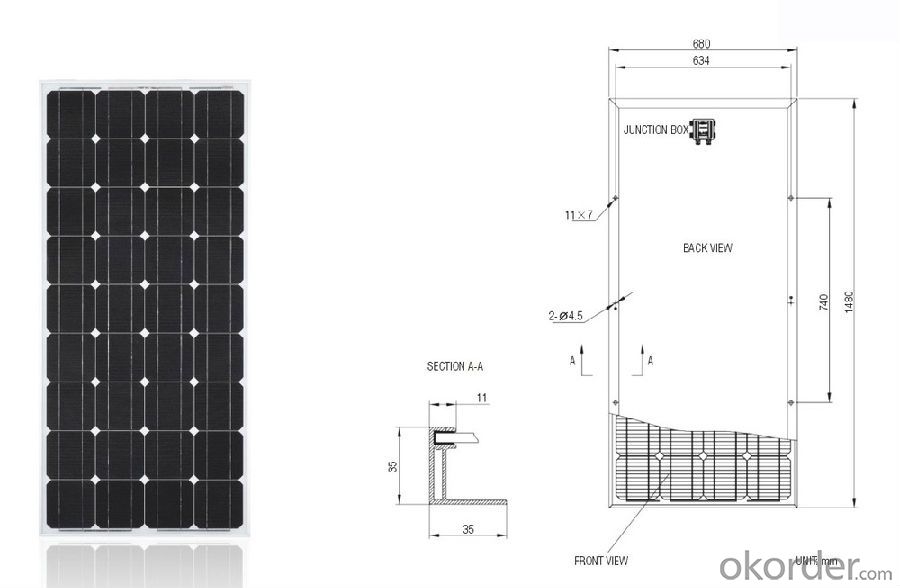
| ELECTRICAL CHARACTERISTICS | |||||||
| Model Number | KM(P)275 | KM(P)280 | KM(P)285 | KM(P)290 | KM(P)295 | KM(P)300 | |
| Maximum Power as per STC | Pmax(W) | 275 | 280 | 285 | 290 | 295 | 300 |
| Power Tolerance | % | ±3% | |||||
| Maximum Power Voltage | Vm(V) | 36.43 | 36.56 | 36.72 | 36.79 | 36.93 | 37.15 |
| Maximum Power Current | Im(A) | 7.55 | 7.66 | 7.77 | 7.89 | 7.99 | 8.08 |
| Open Circuit Voltage | Voc(V) | 43.7 | 42.92 | 44.06 | 44.21 | 44.35 | 44.5 |
| Short Circuit Current | Isc(A) | 8.1 | 8.17 | 8.23 | 8.33 | 8.41 | 8.72 |
| Maximum System Voltage | VDC | 1000 | |||||
| Cell Efficiency | % | 15.7 | 16.0 | 16.3 | 16.6 | 16.8 | 17.1 |
| Module Efficiency | % | 14.2 | 14.5 | 14.7 | 15.0 | 15.2 | 15.5 |
| Cells per Module | Pcs | 72 | |||||
| Cell Type | Polycrystalline silicon | ||||||
| Cell Size | mm | 156 x 156 | |||||
| Bypass Diodes | Pcs | 12Amp, 6 pcs | |||||
| Max. Series Fuse Rating | A | 15A | |||||
| Temperature coefficient of Isc | %/°C | 0.05 | |||||
| Temperature coefficient of Voc | %/°C | -0.35 | |||||
| Temperature coefficient of power | %/°C | -0.47 | |||||
| NOCT- Nominal operating cell temperature | °C | 47 ± 2 | |||||
| Operating Temperature | °C | -40 ~ +85 | |||||
| MECHANICAL CHARACTERISTICS | |||||||
| Dimensions | mm | 1954 x 990 x 50 | |||||
| Weight | Kg | 23.5 | |||||
| Type of Junction Box | TUV certified, IP65 | ||||||
| Cable Type, Diameter | TUV certified, 4mm2, 90 cm in length | ||||||
| Connector | compatible to Type 4 (MC4) | ||||||
| Tempered Glass | 3.2 mm, high transmission, low iron | ||||||
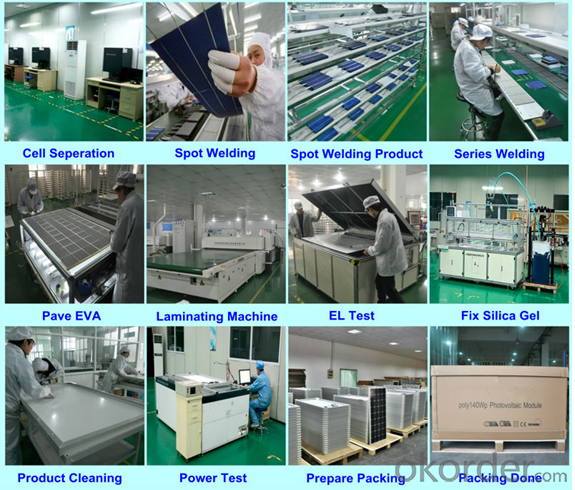 Packing
Packing
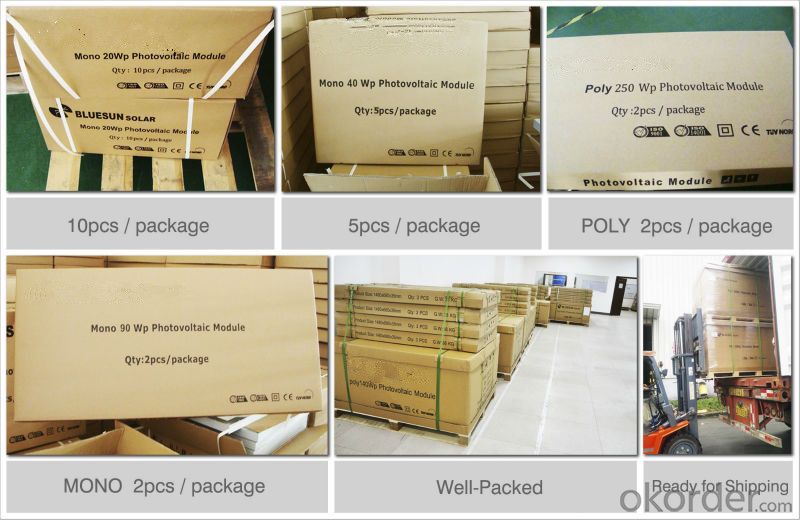
FAQ
1. What kind of Solar Cells does it have
---poly crystalline 156*156mm and 125*125mm or mono 125*125mm and 156*156mm
2. Is the front panel Glass or Plastic
---Tempered glass 3.2mm thickness or adjust to what you need, Light transmittance up to 95%.
3. Does it meet Europe Standards for Solar Energy
---This is TUV approval products, all the producing procedure apply TUV&UL.
4. What is the Efficiency level
--- Between 16-18.9% for solar cells.
5. What is the Nominal Voltage
--- 18v 20v 24v 36v 30v 48v , and so on, we can adjust to what you need.
6. What is the Warranty Period, How many years?
Power efficiency warranty:
---90% in 10 years; 80% in 25 years.
- Q: I'm about to buy one but I don't really know which one is best for my home.
- One will give you enough DC voltage to light a 25 watt light bulb, [ one 45 watt panel is around $400. ] Now if your wanting AC voltage You have to buy a inverter, 5 or 6 deep cycle batteries, a switch Cables to transfer the voltage, a place out side to store the batteries, instalation brackets for the roof A Permit to Install them
- Q: I am writing a lab for school and I need to know who invented solar panels? Any help would be great.
- Many people think that solar power is a new concept. That couldn’t be farther from the truth. Harnessing power from the sun has been dated back to ancient civilizations. The below link is a timeline researched by the Department of Energy that outlines the major historical milestones of solar power.
- Q: Can solar panels be installed on fences?
- Yes, solar panels can be installed on fences. In fact, fence-mounted solar panels have become increasingly popular as they provide an additional space for generating renewable energy without consuming valuable land.
- Q: What things can a solar panel power?
- What things can moving water power? It just depends on the size and number of panels.
- Q: how much electricity will produce in Kwh by a 000 W solar panel in a sunny tropical area per day (good sunlight at least 0 hour a day)
- Duh - 000 W panel (rated in good sunlight) in 0 hours of good sunlight. Let me see - 0 * 000 = 0,000 wh or 0 kwh. Yup.
- Q: Can solar panels be installed on wearable devices?
- Yes, solar panels can be installed on wearable devices. However, due to the limited surface area available on wearables, the amount of energy generated may be relatively low compared to larger solar installations. Additionally, the efficiency of such panels may vary based on the device's orientation to the sun. Nonetheless, incorporating solar panels on wearables can contribute to extending battery life and enhancing their overall sustainability.
- Q: My family and I are looking into solar panels for our home. But I'm unsure how it would be priced. This month our home used ,623 kwh. The solar panel company said we should expect $6-$9 per watt used. What would that put as at?
- OK, KWH stands for Thousand Watts per Hour. You used ,623,000 watt/hours last month. If you pay $6.00 per watt, your bill would be $9,738,000.00. That's right-$9 million,seven hundred and thirty-eight thousand and 00/00.
- Q: Can solar panels withstand extreme weather conditions?
- Yes, solar panels are designed to withstand extreme weather conditions such as high winds, heavy snowfall, and hailstorms. They are made with durable materials and undergo rigorous testing to ensure their resilience.
- Q: Can solar panels be used for powering a wastewater treatment plant?
- Yes, solar panels can be used to power a wastewater treatment plant. Solar energy can be harnessed and converted into electricity, making it a sustainable and environmentally friendly option for powering such facilities. The generated electricity can be utilized to operate various equipment and processes involved in wastewater treatment, reducing dependency on traditional power sources and minimizing the carbon footprint of the plant.
- Q: I have just made my first dolar panel 20 watts, charges my 27TMX Trojan battery perfectly. Now I am thinking to build more solar panels for a grid tie installation at my house, maybe 5 panels would do it, is this safe?
- Homemade okorder
Send your message to us
290w/295w Solar Panels for Heating - Polycrystalline Silicon Certified
- Loading Port:
- Shanghai
- Payment Terms:
- TT OR LC
- Min Order Qty:
- 1000 watt
- Supply Capability:
- 100000000 watt/month
OKorder Service Pledge
OKorder Financial Service
Similar products
Hot products
Hot Searches
Related keywords
